认知语言学
认知语言学

认知语言学
一、引言
在语言学领域中,认知语言学是一门研究人类语言认知过程的分支学科。
通过研究人类认知系统如何处理和理解语言,认知语言学试图探寻语言习得、语言使用以及语言理解背后的认知机制。
本文将深入探讨认知语言学的基本概念、研究方法和相关实践应用。
二、认知语言学的基本概念
认知语言学是一种结合了心理学、语言学和计算机科学的跨学科研究领域。
它关注如何人类的认知系统利用符号系统来组织和理解语言,探究语言如何影响人类思维和表达方式。
认知语言学强调个体在语言过程中的认知能力和处理方式,从而揭示语言和思维之间的密切联系。
三、认知语言学的研究方法
认知语言学采用多种研究方法来探究语言认知过程。
其中,实验研究是认知语言学的主要方法之一,通过实验设计和数据分析,揭示出不同语言任务对认知系统的影响。
另外,神经科学方法、计算模型和语料库分析等也被广泛运用于认知语言学研究中,从不同角度揭示语言处理的认知机制。
四、认知语言学的实践应用
认知语言学的研究成果对语言教学、心理治疗和人机交互等领域具有广泛的应用前景。
通过理解语言认知机制,我们可以改进教学方法,提高语言学习效率;或者通过干预认知过程,帮助患有语言障碍的个体进行康复治疗;同时,认知语言学还为智能机器人和人工智能技术的发展提供了重要的理论支持。
五、结论
认知语言学作为语言学研究中的重要分支,不仅为理解人类语言认知过程提供了新的视角,也为应用性领域的发展带来了新的机遇。
通过深入研究语言和认知之间的关系,认知语言学将继续推动语言学领域的发展,并为人类认知研究带来新的启示。
认知语言学解读
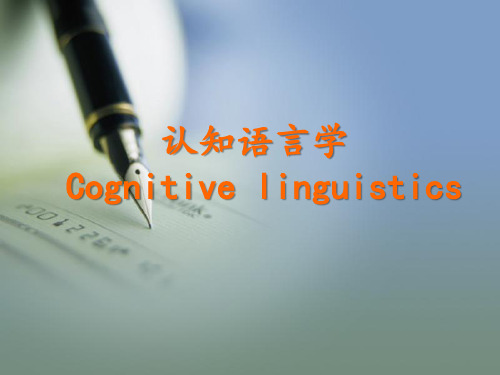
• 戴浩一:台湾国立中正大学语言学研究所教授, 是少数专长于认知语言学的华人。
• 王士元:香港中文大学现代语言学系暨中研院院 士,另一少数专长于认知语言学的华人。
二、认知语言学的主要概念
• 原型 • 范畴化、基本范畴 • 上下位 • 隐喻模式、转喻模式
孕育,80年代中期以后开始成熟。1987年,美国
莱考夫《范畴》的出版,标志着认知语言学的形
成;1989年,勒内·德尔文组织的在德国杜伊斯堡
召开的第一届国际认知语言学大会标志着认知语
言学的正式诞生。90年代中期以后,认知语言学
开始进入稳步发展阶段。
• 认知语言学代表人物
• 乔治·雷可夫 (George P. Lakoff1941年-):认知语言 学的其中一位创立者,提倡比喻(隐喻)是日常语言 活动中的必须认知能力。
• 2.范畴化:
范畴化,也叫做归类,是比较的一个特例。 一个范畴或类别往往有个“原型”,是用以确定 类别的参照标准,需要归类的目标与标准进行比 较,符合标准所有特征的目标例示这一标准,不 完全符合的目标是对标准的扩展。
范畴化,简单地说,就是把不同的事物归为同 一类型的过程。例如:人有各种各样的人,我们把 不同的人统称为“人”,这就是一种范畴化。
认知语言学 Cognitive linguistics
目录
一、什么是认知语言学(定义、 背景、代表人物)
二、认知语言学的主要概念 三、思考探究 四、认知语言学的优与缺 五、认知语言学在中国
一、什么是认知语言学
•
认知语言学是语言学的一门分支学科,它在
反对主流语言学转换生成语法的基础上诞生,在
认知语言学
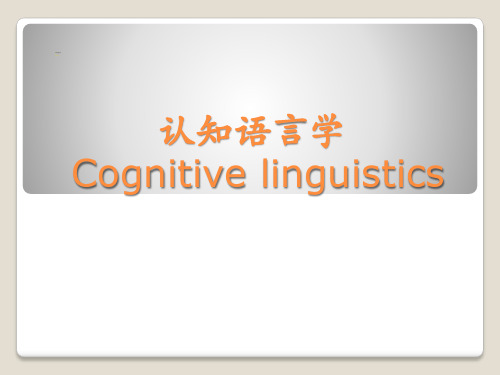
学科发展历程
认知语言学在20世纪70年代中期开始在美国孕育(朗 奴·兰盖克提出空间语法),80年代中期以后开始成熟, 其学派地位得以确立,其确立标志为1989年春由勒内·德 尔文(ReneDirven) 组织的在德国杜伊斯堡(Duisbury) 召 开的第一届国际认知语言学大会。此次大会宣布于1990年 发行《认知语言学》杂志, 成立国际认知语言学( ICLA) , 出版认知语言学研究的系列专著,90年代中期以后开始进 入稳步个特例。一个范 畴或类别往往有个“原型”,是用以确定类别的参照标准, 需要归类的目标与标准进行比较,符合标准所有特征的目 标例示(instantiate)这一标准,不完全符合的目标是 对标准的扩展(extension)。
经典范畴理论的如下特征 1 范畴划分由一组充分必 要条件决定 2 特征是二元 3 范畴具有清晰边界 4 范畴 成员之间地位平等。
eg2.钟书能 阮薇. 认知与忠实——汉英上下位词翻译的认知 视角『j』.韶关学院学报
3.上下位:
以基本层次范畴为中心 范畴可以向上发展为上位范畴向 下发展为下位范畴上位范畴依赖于基本层次范畴 且物体 的完形形象和大部分属性都来自基本层次范畴 因此又被 称为寄生范畴(parasiticcategory) 下位范畴也是寄生范 畴它是在基本层次范畴的基础上更进一步细致的切分。
二、认知语言学的主要概念
原型 范畴化、基本范畴、上下位 命题模式、意象模式、隐喻模式、转喻模式 意象图示
1.原型(prototype):
是物体范畴最好、最 典型的成员, 所有其他成 员也均具有不同程度的典 型性。
eg1. 在英语的世界图景中, 鸟的原型为画眉鸟;而对于 母语为俄语的人而言则是 麻雀; 麻雀在中国人的认 知意义中也具有典型意义。
认知语言学中认知的概念

认知语言学中认知的概念全文共四篇示例,供读者参考第一篇示例:认知语言学是一门研究语言结构和语言运用的学科,旨在探讨语言如何被思维和认知过程所影响,以及语言对认知的影响。
在认知语言学中,认知是一个核心概念,指的是个体获取、处理和组织信息的心智活动,是人类思维和语言现象之间相互作用的关键。
认知的概念在认知语言学中扮演着重要角色,它涵盖了许多方面,包括知觉、注意、记忆、理解、推理、解决问题等。
通过研究认知过程,我们可以揭示语言的运作方式,了解语言的发展和演变,探究语言和思维之间的关系。
认知语言学认为语言是人类思维和认知能力的产物。
语言是一种符号系统,通过语言我们可以表达和交流想法、情感和信息。
在日常生活中,语言贯穿了我们的各个方面,包括学习、记忆、决策、推理等。
通过语言,我们能够思考、表达和理解世界,从而塑造我们的行为和认知模式。
认知语言学还关注语言知识的获取和处理过程。
认知过程涉及到信息的输入、处理和输出,通过这些过程,我们可以获取语言知识、理解语言信息、产生语言表达。
在语言学习过程中,认知过程发挥着至关重要的作用,决定了我们对语言的理解和运用程度。
认知语言学还研究语言对认知的影响。
语言不仅仅是一种表达工具,它还可以影响我们的思维模式和认知能力。
通过语言,我们可以构建概念、理解抽象概念、解决问题、进行推理和思考。
不同的语言体系和语法结构会对个体的思维方式产生不同的影响,这也是语言和认知之间相互作用的体现。
在认知语言学的研究中,认知不仅仅局限于个体的心智活动,还包括了语言和文化之间的关系。
语言是文化的载体,通过语言我们传递文化价值观念、观点和传统。
认知语言学强调在研究语言现象时要考虑到文化背景和文化差异,只有深入理解文化的影响,我们才能更好地理解语言和认知之间的关系。
在总结上述内容的基础上,我们可以得出结论:在认知语言学中,认知是一个核心概念,涉及到个体的思维活动、语言知识获取和处理过程以及语言对认知的影响。
认知语言学
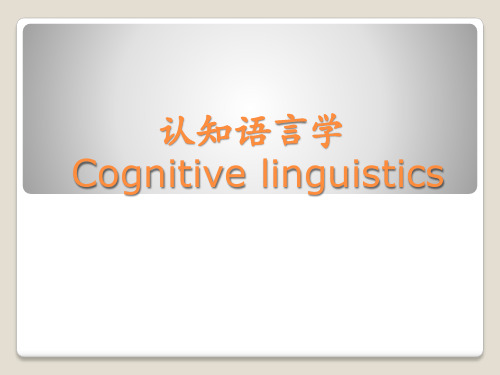
认知语言学代表人物及代表作
乔治·雷可夫 (George P. Lakoff;/ˈleɪˌkɔf/,1941年-):认知语言 学的其中一位创立者,提倡比喻(隐喻)是日常语言活动中的必须认知能 力。
马克·詹森 (Mark Johnson:
朗奴·兰盖克 (Ronald Langacker,1942年12月27日-):认知文法的提 倡者
eg2.钟书能 阮薇. 认知与忠实——汉英上下位词翻译的认知 视角『j』.韶关学院学报
3.上下位:
以基本层次范畴为中心 范畴可以向上发展为上位范畴向 下发展为下位范畴上位范畴依赖于基本层次范畴 且物体 的完形形象和大部分属性都来自基本层次范畴 因此又被 称为寄生范畴(parasiticcategory) 下位范畴也是寄生范 畴它是在基本层次范畴的基础上更进一步细致的切分。
Gilles Fauconnier (1944年8月19日-)
Charles J. Fillmore
William Croft Michael Tomasello (1950年1月18日-)
戴浩一:台湾国立中正大学语言学研究所教授,是少数专长于认知语言 学的华人。
王士元:香港中文大学现代语言学系暨中研院院士,另一少数专长于认 知语言学的华人。
认知语言学 Cognitive linguistics
一、什么是认知语言学 二、认知语言学的主要概念 三、认知语法学 四、认知语言学的研究方法 五、认知语言学优与缺 六、认知语言学在中国
一、什么是认知语言学
认知语言学是语言学的一门分支学科它脱胎自认知心理 学或认知科学,大约在1980年代后期至1990年代开始成型。 认知语言学涉及电脑自然语言理解、人工智能、语言学、 心理学、系统论等多种学科,它针对当时仍很火热的生成 语言学,提出:语言的创建、学习及运用,从基本上都必 须能够透过人类的认知而加以解释,因为认知能力是人类
识解 认知语言学

识解认知语言学1什么是认知语言学?认知语言学是指以认知心理学为基础,研究人类语言产生、理解和运用过程中的心理机制和认知规律。
它提出人类语言能力的本质是一种思维能力,即思考和理解的能力。
在认知语言学中,语言不再是一种外部工具或符号系统,而是与人的思维密切相关的一种认知过程。
2认知语言学的研究范围认知语言学主要研究以下三个方面:2.1语言的认知机制在语言的认知机制方面,认知语言学关注的是人怎么使用和处理语言的。
对于人类在口语和书写上的语言表现,认知语言学能够研究和解释语言的结构、句法、语法、词汇等方面的问题。
2.2语言的语用功能在语言的语用功能方面,研究人们是如何通过语言实现社交交往、交流情感、传递信息等目的的。
通过研究我们使用语言的目的,我们可以更好地了解语言的使用规律。
2.3语言的心理过程在语言的心理过程方面,认知语言学主要研究人类在语言的产生、理解和使用中的心理机制和认知规律。
它探究的是人类大脑如何处理和理解语言,是一种更深入的研究。
3认知语言学和传统语言学的区别和传统语言学相比,认知语言学更加注重语言的使用和语言背后的思维机制。
传统语言学主要关注语言是如何表达意义的,而认知语言学则注重人怎样使用语言去产生意义的。
在认知语言学中,语言不再是表达思想的一种基础,而是思想产生的一种机制。
4认知语言学的应用认知语言学在教育、翻译、语音识别、自然语言处理等领域都有广泛应用。
通过认识到语言的认知本质,我们可以更好地开发教育工具,提高学习效率,也可以提高翻译质量和语音识别能力,让人们更便捷地使用语言和进行人机交互。
5总结总体来说,认知语言学强调了语言和人的思维过程密切相关的认知机制,从而让我们更好地理解人的语言行为、推理和意义生成的本质。
它将语言领域的研究推向了一个更加深刻的层次。
认知语言学的研究目标、原则和方法
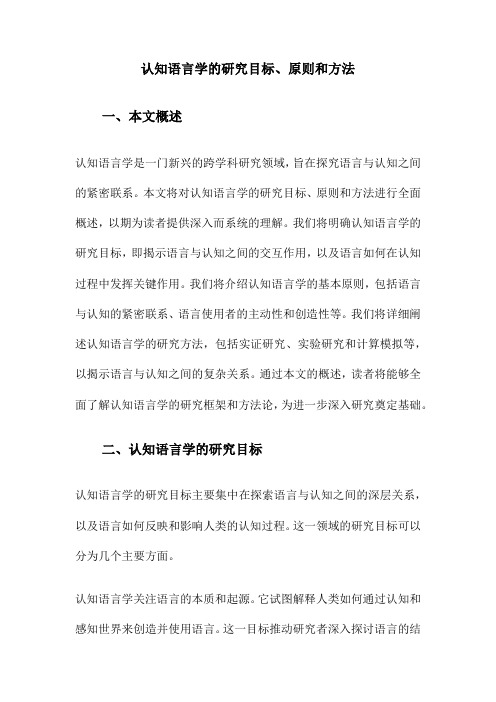
认知语言学的研究目标、原则和方法一、本文概述认知语言学是一门新兴的跨学科研究领域,旨在探究语言与认知之间的紧密联系。
本文将对认知语言学的研究目标、原则和方法进行全面概述,以期为读者提供深入而系统的理解。
我们将明确认知语言学的研究目标,即揭示语言与认知之间的交互作用,以及语言如何在认知过程中发挥关键作用。
我们将介绍认知语言学的基本原则,包括语言与认知的紧密联系、语言使用者的主动性和创造性等。
我们将详细阐述认知语言学的研究方法,包括实证研究、实验研究和计算模拟等,以揭示语言与认知之间的复杂关系。
通过本文的概述,读者将能够全面了解认知语言学的研究框架和方法论,为进一步深入研究奠定基础。
二、认知语言学的研究目标认知语言学的研究目标主要集中在探索语言与认知之间的深层关系,以及语言如何反映和影响人类的认知过程。
这一领域的研究目标可以分为几个主要方面。
认知语言学关注语言的本质和起源。
它试图解释人类如何通过认知和感知世界来创造并使用语言。
这一目标推动研究者深入探讨语言的结构和功能与人类认知能力之间的关系,以揭示语言的本质属性。
认知语言学的研究目标包括探索语言处理的心理机制。
这包括语言的感知、理解、记忆和产生等认知过程。
认知语言学家试图理解这些心理过程如何在大脑中进行,并解释语言处理中的个体差异。
认知语言学还致力于研究语言的演化和发展。
它关注语言是如何随着时间的推移而发生变化的,以及语言变化背后的认知动因是什么。
这一目标的研究有助于揭示语言的演化规律和语言变化对人类社会的影响。
认知语言学的研究目标还包括促进跨语言和文化交流。
通过比较不同语言和文化背景下的认知过程和语言现象,认知语言学家可以增进对不同语言和文化的理解,从而推动跨语言和文化交流的发展。
认知语言学的研究目标涵盖了语言的本质、语言处理的心理机制、语言的演化和发展以及跨语言和文化交流等方面。
这些目标共同构成了认知语言学丰富而多样的研究领域。
三、认知语言学的研究原则现实与认知的互动原则:认知语言学认为语言是人类认知现实的一种方式,是人与世界互动的中介。
认知语言学关键概念 商务印书馆
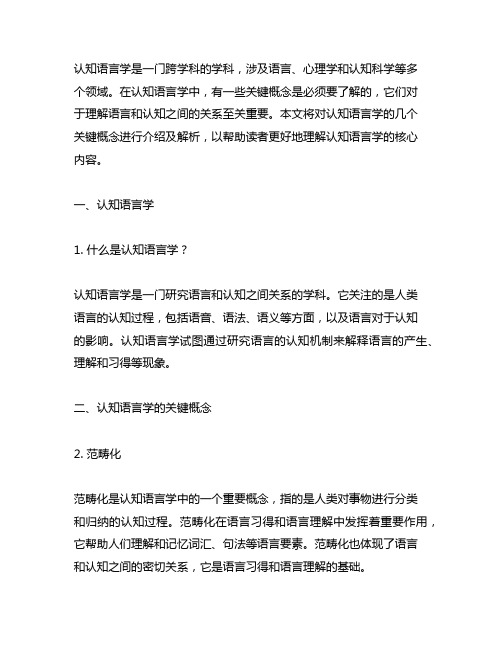
认知语言学是一门跨学科的学科,涉及语言、心理学和认知科学等多个领域。
在认知语言学中,有一些关键概念是必须要了解的,它们对于理解语言和认知之间的关系至关重要。
本文将对认知语言学的几个关键概念进行介绍及解析,以帮助读者更好地理解认知语言学的核心内容。
一、认知语言学1. 什么是认知语言学?认知语言学是一门研究语言和认知之间关系的学科。
它关注的是人类语言的认知过程,包括语音、语法、语义等方面,以及语言对于认知的影响。
认知语言学试图通过研究语言的认知机制来解释语言的产生、理解和习得等现象。
二、认知语言学的关键概念2. 范畴化范畴化是认知语言学中的一个重要概念,指的是人类对事物进行分类和归纳的认知过程。
范畴化在语言习得和语言理解中发挥着重要作用,它帮助人们理解和记忆词汇、句法等语言要素。
范畴化也体现了语言和认知之间的密切关系,它是语言习得和语言理解的基础。
3. 形式规则形式规则是指语言中的语音、语法和语义等形式上的规则和模式。
在认知语言学中,研究者关注形式规则在语言习得和语言理解中的作用。
形式规则帮助人们构建语言结构,理解语言信息,是语言功能实现的基础。
4. 语义网络语义网络是用来表示词汇和词语之间关系的模型,它将语言知识组织成网络状结构,每个节点代表一个词汇或概念,而边表示它们之间的关联。
语义网络在认知语言学中被广泛应用,可以用来解释词语的含义、句子的语义关系等。
5. 语篇分析语篇分析是对语言使用的理解和分析,它涉及到语言的语义、句法、语用等多个层面,旨在揭示语言实际使用的规律和特点。
在认知语言学中,语篇分析有助于揭示语言和认知之间的关系,以及语言在交际和交流中发挥的作用。
6. 意象与概念意象与概念是认知语言学中的重要主题,意象是人类在感觉和感知中形成的多维图像和场景,而概念则是人类对事物的一般性认知和归纳。
意象与概念在语言习得和语言理解中扮演着重要角色,它们帮助人们理解语言信息、构建语言意义。
7. 资源限制理论资源限制理论是认知语言学中的一个重要理论框架,它认为人类认知能力存在一定的资源限制,包括注意力、记忆、语言处理速度等。
认知语言学导论

认知语言学导论认知语言学是一门研究人类语言认知过程的学科,它的发展源于20世纪70年代。
认知语言学的研究对象是语言知识和语言使用,它探讨人类语言能力的本质和机制,以及语言与思维、文化、社会等方面的关系。
一、认知语言学的基本概念1. 语言知识语言知识是指人们对语言的规则、结构、词汇、语法等方面的认知。
它是人类语言能力的基础,也是人们理解和使用语言的前提。
2. 语言使用语言使用是指人们将语言知识应用于交际过程中的行为。
它包括口头和书面语言,以及语言的非语言化表达形式,如手势、面部表情等。
3. 语言认知语言认知是指人们对语言知识和语言使用的认知过程。
它涉及到人类大脑的神经机制、心理过程和认知能力等方面。
二、认知语言学的主要研究内容1. 语言知识的认知机制认知语言学探讨语言知识的认知机制,即人类大脑如何理解和处理语言信息。
它研究语言知识的获取、存储、组织和使用等方面的问题,以及语言知识与其他认知能力的关系。
2. 语言使用的认知过程认知语言学研究语言使用的认知过程,即人们在交际过程中如何理解和表达语言信息。
它探讨语言使用的语用、语境、语言变异等方面的问题,以及语言使用与社会文化、心理因素的关系。
3. 语言与思维的关系认知语言学研究语言与思维的关系,即语言如何影响和反映人类思维过程。
它探讨语言的概念、类比、隐喻等方面的问题,以及语言与文化、社会认知的关系。
三、认知语言学的研究方法1. 行为实验行为实验是认知语言学的主要研究方法之一,它通过对被试者的反应时间、错误率等行为数据进行分析,来探讨语言认知的机制和规律。
例如,一项研究发现,人们在理解带有否定词的语句时,需要花费更多的认知资源,反应时间更长,错误率更高。
这表明否定词对语言理解有一定的干扰作用。
2. 神经影像技术神经影像技术是认知语言学的另一种研究方法,它通过对被试者的大脑活动进行监测和分析,来研究语言认知的神经机制。
例如,一项研究使用fMRI技术发现,当人们听到语言信息时,大脑的听觉区、语言区和认知控制区都会被激活,说明语言认知涉及到多个脑区的协同作用。
认知语言学中认知的概念-概述说明以及解释

认知语言学中认知的概念-概述说明以及解释1.引言1.1 概述概述认知语言学是一门交叉学科,旨在探讨语言与认知之间的关系。
在认知语言学中,认知指的是个体的思维过程,包括知觉、思维、学习、记忆等心理活动。
语言则是人类特有的交流工具,通过语言我们能够表达思想、感情和意图。
认知语言学的研究对象主要包括语言的认知结构、语言习得、语言运用等方面。
通过对认知过程的探究,我们可以更好地理解语言的产生和使用机制,揭示语言习得的规律,促进语言教学和语言治疗的发展。
本文将就认知语言学中认知的概念进行深入探讨,以帮助读者更好地理解认知语言学的基本原理和研究方法。
1.2 文章结构本文主要分为引言、正文和结论三个部分。
在引言部分,我们会概述认知语言学中认知的概念,介绍本文的结构和目的。
接着在正文部分,我们将详细探讨认知语言学的基本概念,分析认知与语言之间的关系,以及探讨认知对语言习得的影响。
最后,在结论部分,我们将总结认知语言学中认知的概念,介绍认知语言学的研究意义,并展望未来研究方向。
通过这样的结构,希望能够全面深入地探讨认知语言学中认知的概念,为读者提供更多的认知角度和理解认知与语言之间的关系。
1.3 目的本文的主要目的是探讨认知语言学中认知的概念,以及认知与语言之间的关系。
通过对认知语言学的基本概念进行介绍,我们将探讨认知对语言习得的影响,从而更深入地理解人类语言能力的本质。
同时,本文还将总结认知语言学中认知的概念,探讨认知语言学的研究意义,以及展望未来研究方向,为进一步探讨语言习得与认知之间的关系提供参考和启示。
通过这篇文章,我们希望让读者对认知语言学的重要性有更深入的认识,为相关领域的研究和教育工作提供有益的指导和借鉴。
2.正文2.1 认知语言学的基本概念认知语言学是一门研究语言习得和使用过程中认知机制的学科。
在认知语言学中,认知指的是指认知过程,即个体对信息的感知、思考、理解和记忆等心理活动。
认知语言学认为,语言的习得和使用离不开认知过程,语言是认知活动的产物。
认知语言学
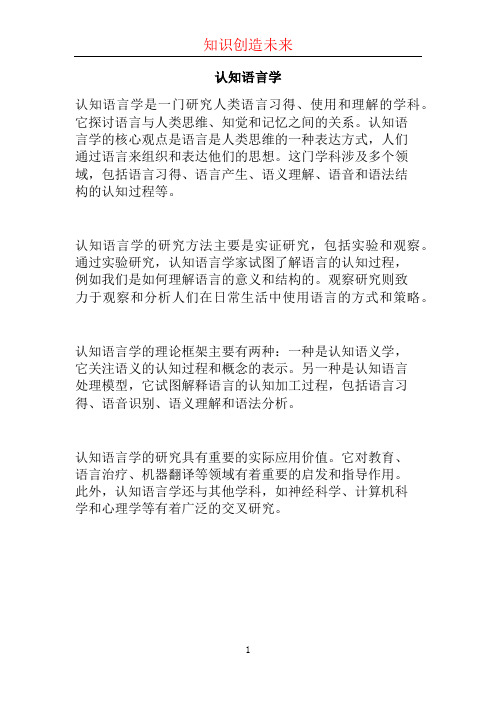
知识创造未来
认知语言学
认知语言学是一门研究人类语言习得、使用和理解的学科。
它探讨语言与人类思维、知觉和记忆之间的关系。
认知语
言学的核心观点是语言是人类思维的一种表达方式,人们
通过语言来组织和表达他们的思想。
这门学科涉及多个领域,包括语言习得、语言产生、语义理解、语音和语法结
构的认知过程等。
认知语言学的研究方法主要是实证研究,包括实验和观察。
通过实验研究,认知语言学家试图了解语言的认知过程,
例如我们是如何理解语言的意义和结构的。
观察研究则致
力于观察和分析人们在日常生活中使用语言的方式和策略。
认知语言学的理论框架主要有两种:一种是认知语义学,
它关注语义的认知过程和概念的表示。
另一种是认知语言
处理模型,它试图解释语言的认知加工过程,包括语言习得、语音识别、语义理解和语法分析。
认知语言学的研究具有重要的实际应用价值。
它对教育、
语言治疗、机器翻译等领域有着重要的启发和指导作用。
此外,认知语言学还与其他学科,如神经科学、计算机科
学和心理学等有着广泛的交叉研究。
1。
乔治·莱考夫认知语言学十讲
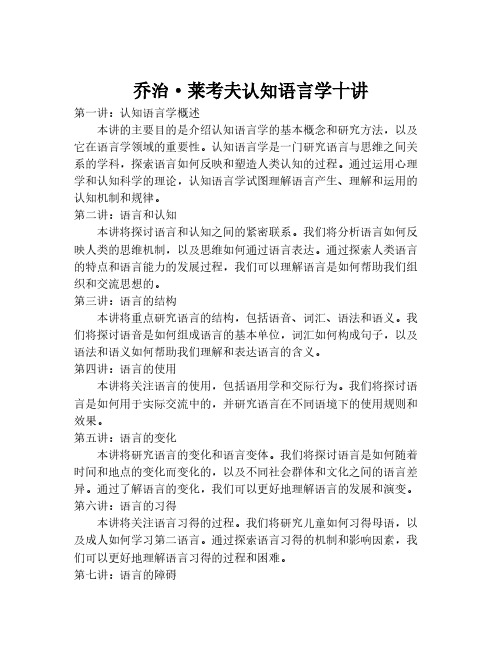
乔治·莱考夫认知语言学十讲第一讲:认知语言学概述本讲的主要目的是介绍认知语言学的基本概念和研究方法,以及它在语言学领域的重要性。
认知语言学是一门研究语言与思维之间关系的学科,探索语言如何反映和塑造人类认知的过程。
通过运用心理学和认知科学的理论,认知语言学试图理解语言产生、理解和运用的认知机制和规律。
第二讲:语言和认知本讲将探讨语言和认知之间的紧密联系。
我们将分析语言如何反映人类的思维机制,以及思维如何通过语言表达。
通过探索人类语言的特点和语言能力的发展过程,我们可以理解语言是如何帮助我们组织和交流思想的。
第三讲:语言的结构本讲将重点研究语言的结构,包括语音、词汇、语法和语义。
我们将探讨语音是如何组成语言的基本单位,词汇如何构成句子,以及语法和语义如何帮助我们理解和表达语言的含义。
第四讲:语言的使用本讲将关注语言的使用,包括语用学和交际行为。
我们将探讨语言是如何用于实际交流中的,并研究语言在不同语境下的使用规则和效果。
第五讲:语言的变化本讲将研究语言的变化和语言变体。
我们将探讨语言是如何随着时间和地点的变化而变化的,以及不同社会群体和文化之间的语言差异。
通过了解语言的变化,我们可以更好地理解语言的发展和演变。
第六讲:语言的习得本讲将关注语言习得的过程。
我们将研究儿童如何习得母语,以及成人如何学习第二语言。
通过探索语言习得的机制和影响因素,我们可以更好地理解语言习得的过程和困难。
第七讲:语言的障碍本讲将探讨语言障碍的原因和特点。
我们将研究语言障碍的种类和症状,以及语言障碍对个体日常交流和学习的影响。
通过了解语言障碍,我们可以更好地帮助有语言障碍的人群。
第八讲:语言与思维本讲将深入研究语言与思维之间的关系。
通过探讨语言如何塑造和影响人类思维的方式,我们可以更好地理解人类思维的本质和不同文化之间的认知差异。
第九讲:语言的演化本讲将关注语言的演化和起源。
我们将研究语言在人类进化中的角色,以及语言起源的理论。
认知语言学主要观点

认知语言学主要观点
1. 语言是认知能力的产物,认知语言学认为语言是人类认知能力的产物,语言的习得和使用与认知过程密切相关。
人们通过认知能力来理解和表达语言,语言的结构和语法规则反映了人类的认知模式和思维方式。
2. 语言与思维密切相关,认知语言学认为语言和思维是密不可分的。
语言不仅是用来表达思想的工具,更重要的是它塑造了人们的思维方式。
不同语言对世界的描述和理解有着不同的方式,这反映了语言对思维的影响。
3. 语言的习得与认知发展相关,认知语言学研究了语言的习得过程,认为语言的习得是与认知发展密切相关的。
儿童在语言习得过程中展现出对语言规则的敏感性和适应性,这反映了他们认知能力的发展。
4. 语言的理解和表达依赖于认知过程,认知语言学认为语言的理解和表达依赖于认知过程,包括注意力、记忆、推理和概念形成等。
人们在理解和表达语言时会运用各种认知策略和技能,这决定了他们对语言的掌握程度和运用能力。
总的来说,认知语言学主要观点强调了语言和认知之间的密切关系,它提供了一种新的角度来理解语言习得、语言理解和语言表达的过程。
通过研究认知语言学,我们可以更好地理解语言的本质和人类认知能力的特点,这对语言教学和语言研究都具有重要的意义。
《认知语言学》课件

语篇的认知模型
认知语言学认为语篇的生成和理解依赖于人们的认知模型 ,如“事件框架”、“信念-愿望模型”等,有助于学生 理解语篇的生成和理解过程。
05
认知语言学的未来发展
认知语言学与其他学科的交叉研究
人机交互
研究如何让机器更好地理解人类语言,实现更加 自然和高效的人机交互。
信息检索与推荐
探究如何利用认知语言学的知识,更加精准地检 索和推荐信息内容。
THANK YOU
比较不同语言的认知模式
探究不同文化背景下语言的认知结构和表达方式,揭示语言的共 性和差异。
跨文化交际中的认知语言学
研究跨文化交际中语言使用背后的认知机制,提高跨文化交流的效 果。
语言与文化认同
探究语言如何塑造和反映文化认同,理解语言在跨文化交流中的重 要角色。
认知语言学的技术应用研究
自然语言处理
利用认知语言学的理论和方法,提高自然语言处 理的准确性和效率。
认知语言学与心理学的交叉
01
研究语言与认知心理过程的相互关系,探究语言习得的机制和
过程。
认知语言学与哲学的交叉
02
探讨语言与意义、真理、知识等哲学问题的关系,深化对语言
本质的认识。
认知语言学与计算机科学的交叉
03
研究自然语言处理和人工智能等领域,实现机器对人类语言的
认知理解和生成。
认知语言学的跨文化研究
语言的动态性
语言的动态性
语言是一个动态的过程,随着社 会、文化和认知的变化而不断发
展变化。
语言的演变
语言的动态性表现在词汇、语法和 语义等方面的演变,这些演变是由 社会、文化和认知的变化所驱动的 。
认知语言学的分类

认知语言学的分类
认知语言学是一种研究人类语言能力及其认知机制的语言学派别。
其研究范围包括语言的认知和运用过程,语言的逻辑结构及其对人类思维的影响等。
认知语言学在语言学及其他相关领域中有着广泛的应用,被视为一种重要的语言研究方法。
认知语言学的分类主要有以下几种:语义学、句法学、语音学、语用学和心理语言学。
语义学是认知语言学的一个重要分支,主要研究语言的意义和语义结构。
其研究范围包括词汇的语义、句子的含义、语义逻辑等。
语义学的研究方法主要是基于语料库的分析和认知实验的数据收集。
句法学是研究语言的句法结构和组织规律的学科。
它关注的是句子和短语的结构、语法规则和语法关系等。
句法学的研究方法主要是基于语言分析和实验研究。
语音学是研究语音和音位系统的学科。
它主要关注语音的构成、语音音位的规律和语音变化等。
语音学的研究方法主要是基于语音分析和实验研究。
语用学是研究语言的使用和交际功能的学科。
它主要关注语言在交际中的作用和功能。
语用学的研究方法主要是基于语言分析和实验研究。
心理语言学是研究语言和心理过程之间关系的学科。
它主要关注语言在认知和心理过程中的作用和影响。
心理语言学的研究方法主要是基于认知实验和神经科学的技术研究。
总体来看,认知语言学的分类覆盖了语言学的多个领域,涵盖了语言的各个层面,从语音到语义,再到语用和心理过程。
这些分类提供了一个更加细致和全面的视角,帮助我们更好地理解和探究语言的本质和特点。
认知语言学外语教育学(一)2024

认知语言学外语教育学(一)引言概述:认知语言学是研究语言与认知关系的学科,它为外语教育提供了新的理论视角和方法。
本文通过几个大点来探讨认知语言学在外语教育学中的应用。
首先,我们将介绍认知语言学的基本概念和理论框架。
然后,我们将详细讨论认知语言学对外语教学的影响,包括其在词汇教学、语法教学、听力和口语训练以及写作教学中的应用。
最后,我们将总结认知语言学对外语教育学的重要意义,以及未来的发展方向。
正文:1. 认知语言学的基本概念和理论框架- 描述认知语言学的定义和目标- 解释认知语言学的理论框架,如心理语言学和语言认知处理等- 探讨认知语言学与其他学科的关系,如心理学、神经科学等2. 认知语言学在词汇教学中的应用- 分析词汇认知的过程和机制- 探讨词汇教学中的认知策略,如语义网络、联想记忆等- 讨论认知语言学对词汇教学的影响和启示3. 认知语言学在语法教学中的应用- 阐述语法认知的概念和特点- 讨论认知语法教学的策略和方法,如意义导向教学、概念映射等- 总结认知语言学对语法教学的价值和意义4. 认知语言学在听力和口语训练中的应用- 分析听力和口语认知的过程和特点- 探讨认知语言学对听力解码和口语产出的影响- 讨论认知语言学在听力和口语训练中的策略和方法,如认知负荷理论、语篇分析等5. 认知语言学在写作教学中的应用- 阐述写作认知的过程和特点- 探讨认知语言学对写作教学的影响和启示- 讨论认知语言学在写作教学中的策略和方法,如思维导图、意义导向写作等总结:认知语言学作为一门研究语言与认知关系的学科,对外语教育学具有重要影响。
通过认知语言学的理论框架,可以更好地理解词汇、语法、听力、口语和写作等方面的教学。
词汇教学可以通过认知语言学的认知策略提高学生的词汇记忆和运用能力;语法教学可以通过认知语言学的方法帮助学生理解和运用语法知识;听力和口语训练可以借鉴认知语言学的认知负荷理论来提高学生的听说能力;写作教学可以通过认知语言学的策略和方法来培养学生的写作思维。
认知心理学中的认知语言学和对比语言学
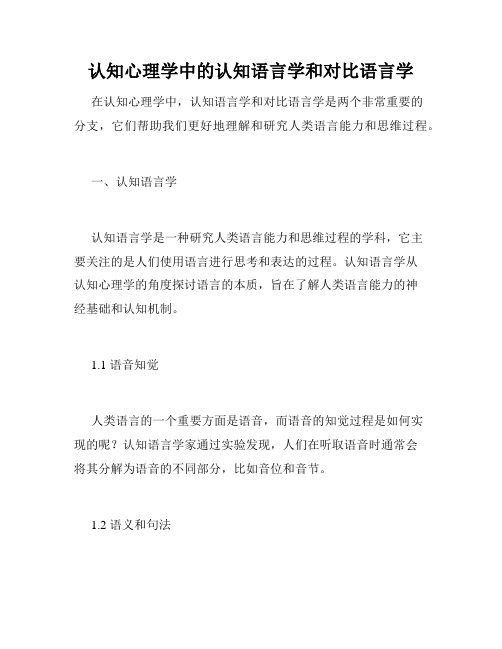
认知心理学中的认知语言学和对比语言学在认知心理学中,认知语言学和对比语言学是两个非常重要的分支,它们帮助我们更好地理解和研究人类语言能力和思维过程。
一、认知语言学认知语言学是一种研究人类语言能力和思维过程的学科,它主要关注的是人们使用语言进行思考和表达的过程。
认知语言学从认知心理学的角度探讨语言的本质,旨在了解人类语言能力的神经基础和认知机制。
1.1 语音知觉人类语言的一个重要方面是语音,而语音的知觉过程是如何实现的呢?认知语言学家通过实验发现,人们在听取语音时通常会将其分解为语音的不同部分,比如音位和音节。
1.2 语义和句法语言的另一个关键方面是语义和句法。
认知语言学家认为,人类语言能力的核心是语法,在语法的帮助下,人们能够产生无限的、合乎语法的句子。
语义则是指句子的意义,它包括单词之间的关系、上下文以及语言中的语音、触感、视觉和其他感官信号。
1.3 语言习得语言习得是认知语言学中的一个重要研究方向。
该领域的研究主要关注儿童语言习得过程中的认知机制和发展趋势。
二、对比语言学对比语言学则是以比较的方式研究语言,通过比较不同语言之间的差异和相似之处,来揭示语言的共性和个性。
相比于认知语言学而言,对比语言学更注重语言的文化因素以及语言与文化的相互联系。
2.1 语言的分类对比语言学的第一步是语言的分类。
语言可以按照某些特征分类,比如语音、语法、词汇等。
通常认为,语言可以分为语系、语族和语种。
语系是指互相间有关联的语言,如印欧语系、汉藏语系等。
语族则是指具有同一祖先语的语言,如日耳曼语族、斯拉夫语族等。
语种则是指特定语言的不同形态,如英语、德语、法语等。
2.2 语言的结构对比语言学主要关注语言的结构。
语言结构包括语音、词汇、语法等方面,每种语言都有其独特的结构。
比如,中国话与英语在语音方面的差异就很大,这导致两种语言都有独特的语音系统和特有的音素。
2.3 语言与文化对比语言学的另一个重要研究方向是语言与文化之间的关系。
认知语言学

语法化研究
语法化通常是指语言中意义比较实在的 词逐渐转化为意义虚灵的表示语法功能 的语法成分的过程或现象
4、隐喻由两个域构成,一个结构相对清晰的始源域,一个结构 相对模糊的目标域,隐喻就是将前结者的图式结构映衬到目标域 上,让我们通过始源域的结构来构建和理解目标域。
5、隐喻映射不是随意产生的,而是植根于我们的身体经验。一 个隐喻一旦建立起来,为大多数语言使用者所接受,就会反过来 将自身的结构强加于真实生活之上,从而以各种各样的方式被实 现。
突显观
语言结构中的的信息的选择与安排是由 信息的突显度决定的
注意观
用语言所表达的实际上只反映了事件中 引起我们注意的那些部分,而对事件过 程中的一些其他细节在语言中却得不到 体现
古典范畴理论
1、范畴由一组充分必要条件决定。 2、范畴的所有特性均为二元的。用逻辑语言
来表达的话,一个特性只可能有两个值,/+/ 或/—/。 3、各范畴有自己界定清晰的边线。一个范畴 一旦建立起来,就将世界分为两部分——属 于该范畴的部分和不属于该范畴的部分。 4、范畴的所有成员均地位平等。凡是具备了 某范畴所有充分必要条件的个体即为该范畴 的成员,凡是不具备该范畴所有充分必要条 件的个体却不为该范畴的成员。
第八章认知语言学派
什么是认知语言学
认知语言学是现代认知科学与语言学研 究相结合发展而成的一个新的语言学流 派,是从认知的角度来研究语言现象的 一种研究方法,它既可动用认知科学的 理论来解释语言现象,又可通过研究语 言现象发现语言中有关人类认知的规律 性的东西,进一步揭示认知和语言间的 关系。
- 1、下载文档前请自行甄别文档内容的完整性,平台不提供额外的编辑、内容补充、找答案等附加服务。
- 2、"仅部分预览"的文档,不可在线预览部分如存在完整性等问题,可反馈申请退款(可完整预览的文档不适用该条件!)。
- 3、如文档侵犯您的权益,请联系客服反馈,我们会尽快为您处理(人工客服工作时间:9:00-18:30)。
